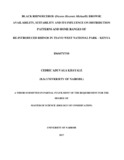| dc.contributor.author | Khayale, Cedric A | |
| dc.date.accessioned | 2017-11-21T08:19:33Z | |
| dc.date.available | 2017-11-21T08:19:33Z | |
| dc.date.issued | 2017 | |
| dc.identifier.uri | http://hdl.handle.net/11295/101347 | |
| dc.description.abstract | Black rhino home range and distribution patterns in the Intensive Protection Zone (IPZ) of Tsavo West National Park were determined from GPS locations data using Arc View . The IPZ home ranges were categorised into high use area (50 % MCP) and low use area (95% MCP). Home range areas in the Tsavo West National Park - IPZ of 7.5 – 696.4 km2 (MCP) were larger than many elsewhere. This may in some way indicate a low browse availability or low preferred browse for black rhinoceros, but it is probable that other factors were in play for the higher home range sizes. Home range sizes and distribution patterns of rhinos in the IPZ varied among sexes, seasons and source areas. No difference in home range sizes and distribution of all rhinos in the IPZ for the dry and wet seasons was evident (t (1) = 2.2188, P = 0.2696 with P>0.05). Female rhinos ranged further and had bigger home ranges as compared to male rhinos in the IPZ (t(1) = 71, P = 0.008966 with P<0.05) . Nakuru Rhinos ranged further from their release sites and had larger home ranges during both seasons than Ngulia Rhinos.
Black rhino browse availability (BA) and suitability was studied within Ngulia rhino sanctuary and the surrounding intensive protection zone (IPZ). Plant species suitability rating was determined based on preference ratios. Preference ratings were used to determine and distinguish preferred plant species from those not preferred in relation to rhino utilization. Browse availability in Ngulia, IPZ, IPZ high use and IPZ low use area were then grouped based on suitability/preference ratings.
Browse availabilty was assessed in the 0 to 2 meters primary feeding layer of black rhino over each plot. t- Test was applied to test for differences in browse within and between the two study sites. Plant species diversity and community similarity was also determined and compared in the study sites. Ngulia had a higher browse availability for all plant species and for preferred plant species than the IPZ. A higher diversity of all species and a higher diversity of preferred plant species was found in IPZ than Ngulia. IPZ and Ngulia were found to have a slight similarity in the composition of all species and preferred plant species. There was no significant difference in the BA for high use and low use areas of the IPZ. The high use area was found to have a higher diversity of preferred plant species than the low use area of the IPZ. Higher diversity of plant species and more so of preferred plant species in the IPZ influenced the home range sizes and distribution patterns of rhinos. | en_US |
| dc.language.iso | en | en_US |
| dc.publisher | University of Nairobi | en_US |
| dc.rights | Attribution-NonCommercial-NoDerivs 3.0 United States | * |
| dc.rights.uri | http://creativecommons.org/licenses/by-nc-nd/3.0/us/ | * |
| dc.subject | Black Rhinoeceros | en_US |
| dc.title | Black Rhinoeceros (Diceros Bicornis Michaelli) Browse Availability, Suitability And Its Influence On Distribution Patterns And Home Ranges Of Re-Introduced Rhinos In Tsavo West National Park – Kenya | en_US |
| dc.type | Thesis | en_US |



